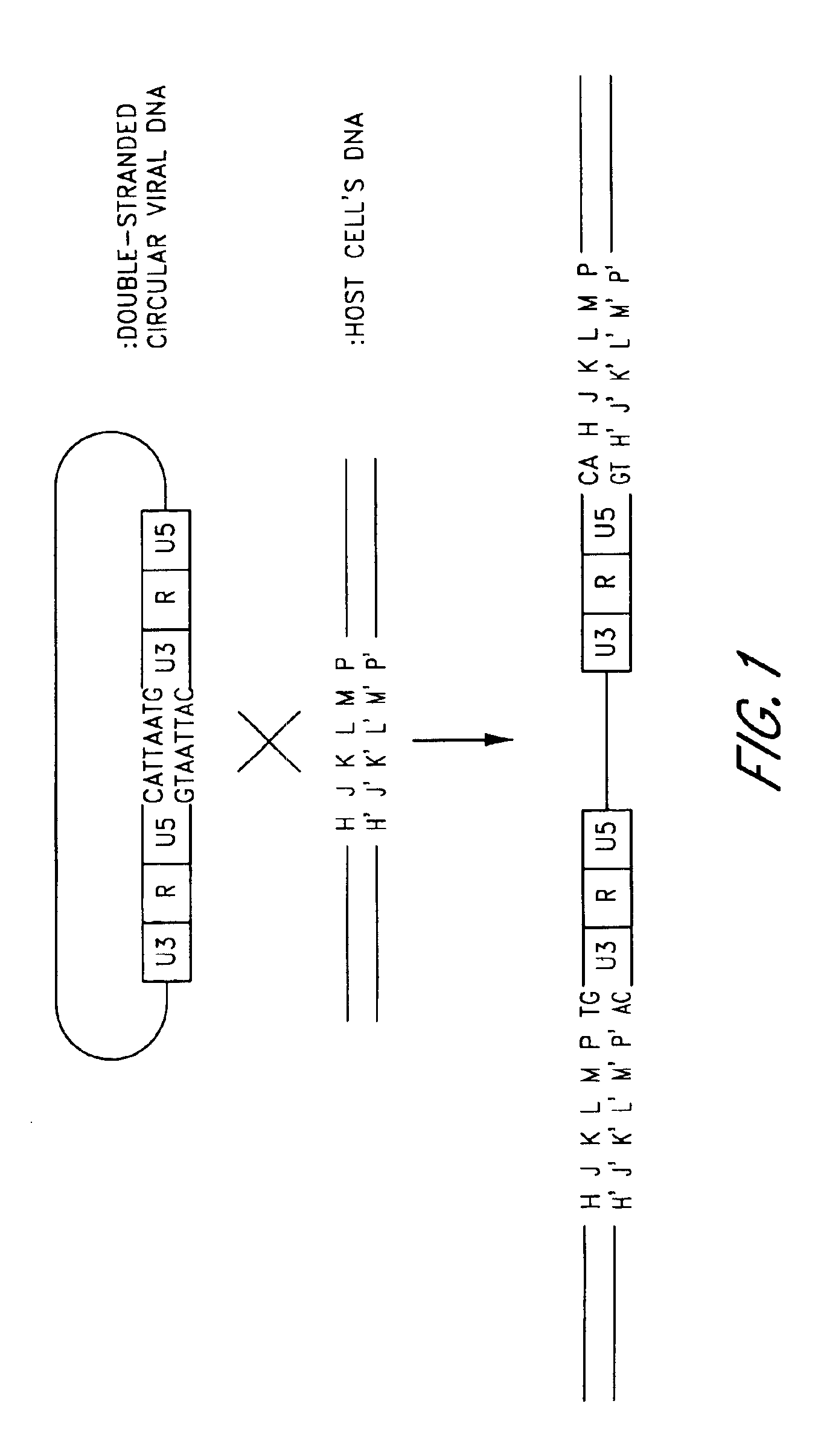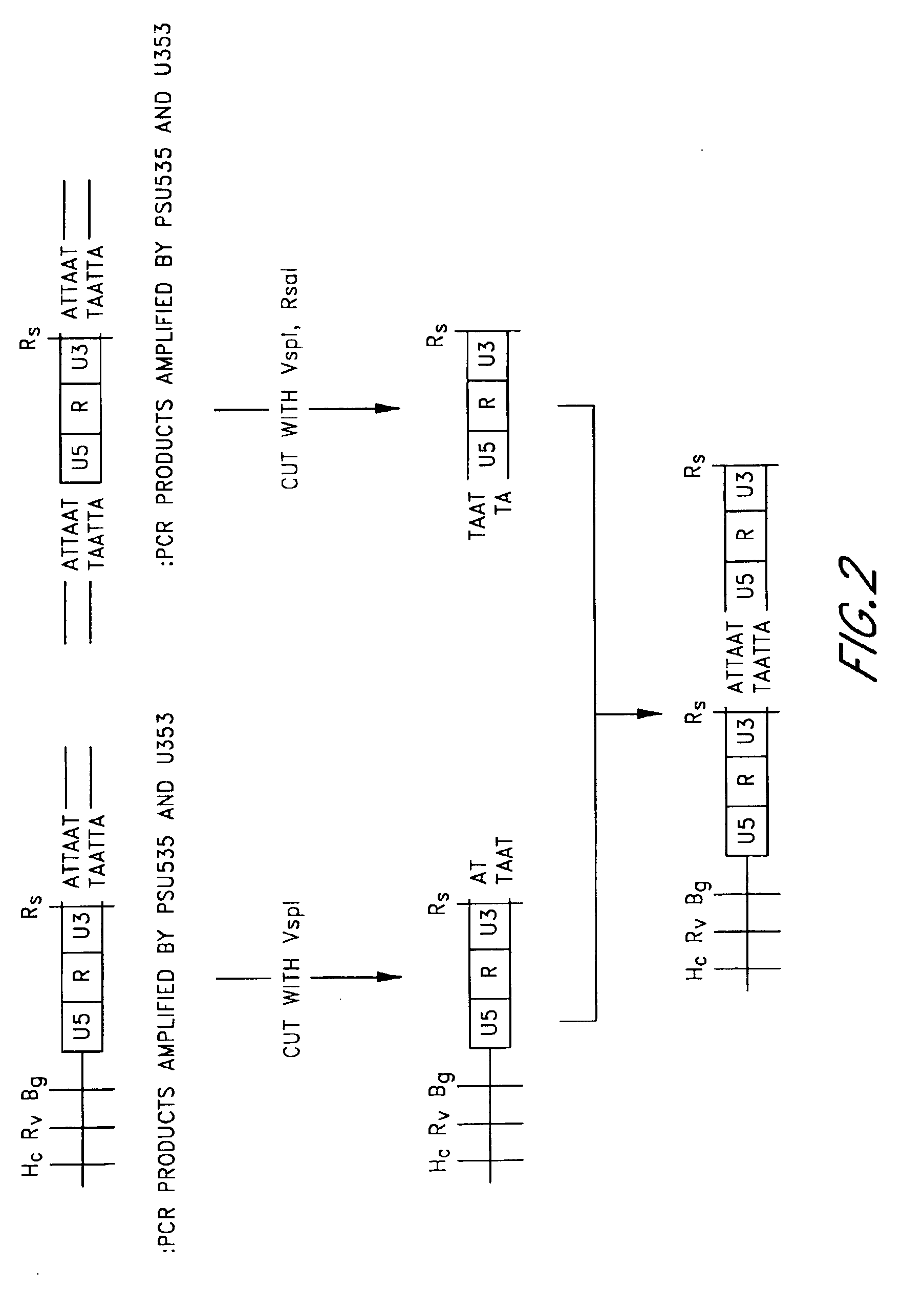Plasmid vector comprising a retroviral integrase gene and an integrase recognition region
- Summary
- Abstract
- Description
- Claims
- Application Information
AI Technical Summary
Benefits of technology
Problems solved by technology
Method used
Image
Examples
example 1
Construction of Genome-integration Type Vectors
(1-1) Amplification of LTR Region and Integrase Gene Region
[0223]Fertilized eggs of white leghorn chicken of Line-M(C / O), which were free from retroviruses, were incubated. On day 12, fibroblasts were prepared from the embryos and were infected with the Rous sarcoma virus (which is referred to as “RSV”, hereinafter. The viruses are provided by the Nippon Institute for Biological Science).
[0224]Two days after infection, DNA was prepared from the cells according to the standard methods (Molecular Cloning, 2nd ed.: Cold Spring Harbor Laboratory Press, 1989., referred to as “M. C.” hereinafter).
[0225]The primers used in PCR were synthesized according to the RSV nucleotide sequences described in the article by Schwartz, D. E. et. al. (Cell, 32, 853-869, 1983). The nucleotide sequences of the synthesized primers are as follows:[0226]U353: 5′-GGCATTAATGTAGTCTTATGCAATACTCCTG-3′ (SEQ ID NO: 1)[0227]PSU535: 5′-GTTAACGATATCAGATCTGCTTGATCCACCGGGCGA...
example 2
Transfection and Analysis
[0256]pLTR43 and pLTR435 were individually introduced into the MEL cells derived from murine Friend leukemia (purchased from RIKEN Cell Bank) using the Transferrinfection kit (Bender MedSystems).
[0257]The cells were passaged such that they were diluted 10-fold from one generation to the next. DNA prepared from the cells of after third passage was subjected to nested PCR and southern hybridization.
(2-i) Nested PCR
[0258]The DNA containing the vectors prepared from cells was subjected to nested PCR using TaKaRa LA in vitro cloning kit. The principle thereof is shown in FIG. 8. As shown in FIG. 8, PSU535 and U535 was used as a primer 1 and 3 respectively. A Cassette Primer C1 and a Cassette Primer C2 included in the kit were used as primers 2 and 4, respectively.
[0259]The size of a fragment or fragments that are amplified by PCR and appear as a band or bands varies depending on the distance between the integrated vector and a recognition sequence for HindIII (sh...
example 3
Introduction of a Gene into Chickens
[0266]Fertilized eggs of white leghorn chicken of Line-M(C / O) described above, which were free from retroviruses, were incubated for 48 hours. On one side of each egg was formed a window having a diameter of about 1 cm, through which a DNA-transferrin-poly L lysine complex prepared by the transferrinfection kit (i.e., the same complex as that used in Example 2 for the purpose of the transfection into MEL cells) was injected into the lower cavity of a blastoderm of embryos at a development stage in an amount of about 2 ul / embryo using a glass capillary tube. The window was sealed with a strip of vinyl tape and incubation was continued until hatching. Blood samples were collected from the wing vein of the chicks two weeks after hatching.
[0267]DNA was prepared from the blood using GenomicPrep™ Blood DNA Isolation KIT (Pharmacia), and PCR was performed using primers IN53 and PO35. The results are shown in FIG. 12.
[0268]As shown in FIG. 12, no distinct...
PUM
 Login to View More
Login to View More Abstract
Description
Claims
Application Information
 Login to View More
Login to View More - R&D
- Intellectual Property
- Life Sciences
- Materials
- Tech Scout
- Unparalleled Data Quality
- Higher Quality Content
- 60% Fewer Hallucinations
Browse by: Latest US Patents, China's latest patents, Technical Efficacy Thesaurus, Application Domain, Technology Topic, Popular Technical Reports.
© 2025 PatSnap. All rights reserved.Legal|Privacy policy|Modern Slavery Act Transparency Statement|Sitemap|About US| Contact US: help@patsnap.com



